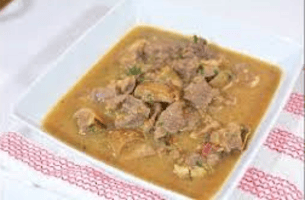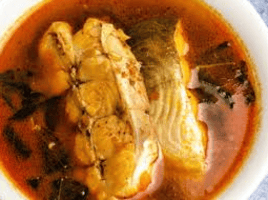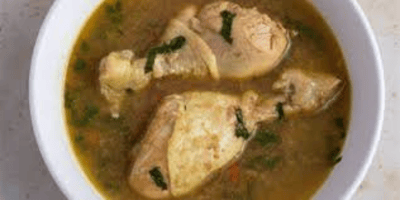When the chill of evening sets in or you’re feeling under the weather, few dishes offer the same comforting warmth and aromatic experience as a steaming bowl of African pepper soup.
This traditional West African delicacy has gained worldwide recognition for its unique blend of spices, tender meat, and incredible health benefits. This guide will explore the rich history, health benefits, and regional variations of African pepper soup before diving into detailed recipes that you can recreate in your own kitchen.
From selecting the perfect pepper soup spice blend to serving suggestions that elevate your dining experience, this post covers everything you need to know about this beloved West African classic.

The Cultural Significance of African Pepper Soup
African pepper soup transcends being merely a culinary delight—it holds profound cultural significance across West African communities. In Nigeria, where it’s particularly revered, pepper soup features prominently at celebrations, family gatherings, and traditional ceremonies.
Many West Africans consider this spicy broth a natural remedy, often prepared for new mothers to help with postpartum recovery or served to those battling colds and fevers.
In coastal areas, fish versions predominate, while inland communities favor goat, beef, or chicken varieties. Despite these variations, the essence remains consistent: a flavorful, warming soup that connects people to their heritage.
Health Benefits of African Pepper Soup
African pepper soup offers remarkable health benefits beyond its delicious taste:
Immune System Support
The combination of pungent peppers, garlic, and ginger provides natural immune-boosting properties that help fight off infections.
Respiratory Relief
The spicy nature of African pepper soup helps clear congestion and provides relief from cold and flu symptoms.
Anti-inflammatory Properties
Many ingredients in traditional pepper soup spice blends contain natural anti-inflammatory compounds that may help reduce inflammation in the body.
Digestive Aid
The aromatic spices stimulate digestive enzymes, potentially improving overall digestion and nutrient absorption.
Antioxidant Rich
The variety of herbs and spices in African pepper soup delivers potent antioxidants that help combat free radicals in the body. These health-promoting qualities explain why African pepper soup has been trusted for generations as both preventative medicine and comforting nourishment during illness.
Essential Ingredients for Authentic African Pepper Soup
Creating truly authentic African pepper soup requires understanding its foundational ingredients:
Protein Base
Goat meat, beef, chicken, or fish serve as traditional protein sources, each lending unique characteristics to the finished soup.
Pepper Soup Spice Mix
- This signature blend typically includes: African negro pepper (uda)
- African nutmeg (ehuru)
- Grains of paradise (alligator pepper)
Heat Elements
Scotch bonnet peppers, habaneros, or African bird’s eye chilies provide the characteristic spicy kick.
Aromatic Enhancers
Onions, garlic, and ginger form the aromatic foundation that builds depth of flavor.
Herbs and Seasonings
Fresh herbs like utazi leaves, or scent leaf (basil) add distinctive Nigerian flavor profiles.
Stock Base
A rich bone broth or vegetable stock forms the liquid foundation of the soup. The beauty of African pepper soup lies in its adaptability—while certain elements remain constant, home cooks can adjust ingredients based on availability and personal preference while maintaining the soul of the dish.
Classic Goat Meat African Pepper Soup Recipe
This recipe delivers an authentic goat meat pepper soup experience that stays true to West African traditions while using ingredients accessible in most locations.

Ingredients
For the Meat:
- 2 pounds goat meat, cut into medium chunks
- 1 large onion, roughly chopped
- 3 garlic cloves, minced
- 1-inch ginger piece, peeled and minced
- 2 tablespoons African pepper soup spice mix
- Salt to taste
For the Soup:
- 8 cups water or meat stock
- 2-3 Scotch bonnet peppers (adjust according to heat preference)
- 2 tablespoons ground crayfish (optional but authentic)
- 2 tablespoons palm oil (optional)
- 2 bouillon cubes (chicken or beef flavor)
- Fresh utazi leaves (substitute with spinach if unavailable)
- Fresh herbs like basil (scent leaves) or mint for garnish
Equipment Needed:
- Large pot with lid
- Sharp knife and cutting board
- Wooden spoon
- Measuring spoons and cups
- Mortar and pestle (ideal but not essential)
Preparation Instructions
Prepare the Meat
Clean the goat meat thoroughly, removing any excess fat if desired. Place in a large bowl and rinse with water. For traditional preparation, some cooks rinse with lemon or lime juice to remove any gamey flavor.
Season the Meat
In a large pot, combine the goat meat with chopped onions, minced garlic, ginger, one tablespoon of the pepper soup spice mix, and a pinch of salt. Mix well to ensure even coating of the meat with the seasonings.
Begin the Cooking Process
Add enough water to cover the meat and bring to a boil over medium-high heat. Reduce heat to medium-low, cover partially, and simmer for about 45-60 minutes until the meat begins to tenderize.
Create the Soup Base
Once the meat has started to become tender, add the remaining water or stock to the pot. Add the remaining pepper soup spice mix, ground crayfish if using, and bouillon cubes.
Add the Heat Element
Add the Scotch bonnet peppers either whole (for milder heat that infuses flavor) or chopped (for more intense spiciness). If using palm oil, add it at this stage for richness and color.
Simmer to Perfection
Allow the soup to simmer for an additional 15-20 minutes until the meat is completely tender and the flavors have melded together beautifully.
Finish with Fresh Elements
In the last 5 minutes of cooking, add the fresh utazi leaves (or substitute greens). Taste and adjust seasoning as needed.
Serve
Ladle the hot soup into bowls, ensuring each serving contains generous portions of meat. Garnish with fresh herbs if desired.
Fish African Pepper Soup Variation
For a lighter yet equally flavorful alternative, this fish-based pepper soup offers a delicious option:

Ingredients:
- 2 pounds firm white fish (tilapia, catfish, or snapper work well), cut into large chunks
- 1 large onion, sliced
- 3 garlic cloves, minced
- 1-inch piece ginger, grated
- 2 tablespoons African pepper soup spice mix
- 1-2 Scotch bonnet peppers, deseeded if preferred
- 6 cups fish stock or water
- Fresh herbs (basil, mint, or parsley)
- 2 tablespoons ground crayfish (optional)
- Salt to taste
- Lime or lemon wedges for serving
Preparation
Prepare the Fish
Clean the fish thoroughly and cut into large chunks. Sprinkle with a little salt and keep aside.
Create the Flavorful Base
In a large pot, bring the fish stock or water to a gentle simmer. Add one tablespoon of the pepper soup spice blend, along with the onions, garlic, and ginger.
Build the Soup
Add the Scotch bonnet peppers and ground crayfish if using. To produce a flavorful broth, let it simmer for around ten minutes.
Cook the Fish
Gently place the fish chunks into the simmering broth, being careful not to break them. Add the remaining pepper soup spice and adjust seasonings.
Finish Cooking
Simmer gently for 10-12 minutes until the fish is just cooked through but still moist and tender.
Serve
Take off the heat and add some fresh herbs. Serve hot, accompanied by diced pieces of lemon.
Vegetarian African Pepper Soup
This plant-based version maintains the characteristic flavors of African pepper soup while offering a meat-free alternative:
Ingredients:
- 2 cups mixed mushrooms (oyster, shiitake, or button), roughly chopped
- 1 cup plantains, diced
- 1 cup yams or sweet potatoes, diced
- 1 cup bell peppers, diced
- 1 large onion, chopped
- 4 garlic cloves, minced
- 1-inch piece ginger, minced
- 2 tablespoons African pepper soup spice mix
- Scotch bonnet peppers(1 or 2) adjust according to taste
- 6 cups vegetable stock
- 2 tablespoons palm oil (optional)
- Fresh spinach or kale leaves
- Fresh herbs for garnish
- Salt to taste

Preparation
Prepare the Base
Heat palm oil (if using) in a large pot. Sauté the ginger, garlic, and onions until they are transparent and fragrant.
Add Hearty Vegetables
Add the diced yams or sweet potatoes to the pot along with half the pepper soup spice mix. Cook-ideally for 5minutes and stir from time to time.
Build the Soup
Pour in the vegetable stock and bring to a simmer. Add plantains, bell peppers, and mushrooms.
Add Heat and Flavor
Add the Scotch bonnet peppers and remaining pepper soup spice. Simmer until vegetables are tender but not mushy, about 15-20 minutes.
Finish with Greens
Stir in fresh spinach or kale leaves and allow to cook a little. Adjust seasoning to taste.
Serve
Hot, garnished with fresh herbs.
Making Your Own African Pepper Soup Spice Mix
While pre-made spice mixes are available in African grocery stores, creating your own blend allows for customization and ensures freshness:
Basic Pepper Soup Spice Mix:
- 2 tablespoons African negro pepper (uda)
- 2 tablespoons African nutmeg (ehuru)
- 1 tablespoon ground alligator pepper
- 1 teaspoon dried ginger
- 1 teaspoon dried garlic
- 1 teaspoon dried thyme
- 1 teaspoon black peppercorns
Preparation:
Dry roast whole spices lightly in a pan to release essential oils. Allow to cool completely before grinding in a spice grinder or with mortar and pestle until fine. Keep out of direct sunlight and heat in an airtight container for up to 3 months.
If certain African spices are unavailable, substitutions can include black pepper, regular nutmeg, cardamom, and cloves, though the flavor profile will differ slightly from traditional versions.
Tips for Perfect African Pepper Soup Every Time
Heat Management
The key to enjoyable African pepper soup is balancing heat levels. Use whole chilies for milder heat that can be removed before serving or chop finely for more intense spiciness.
Meat Selection
For meat-based soups, choose cuts with some fat and connective tissue that break down during the slow cooking process, creating rich flavor and texture.
Simmering Time
Patience yields rewards—allow sufficient simmering time for flavors to develop fully and proteins to become tender.
Storage Tips
African pepper soup often tastes even better the next day as flavors continue to develop. You can freeze it for up to three months or keep it in the fridge for up to three days.
Temperature Control
Maintain a gentle simmer rather than a rolling boil to prevent meat from toughening or fish from falling apart.
Troubleshooting Common Issues:
Too Spicy:
Add a small amount of plain yogurt or cream when serving to temper the heat or increase the liquid ratio in the soup.
Tough Meat:
Continue cooking at a low simmer until tender. If still tough, transfer to a pressure cooker to speed up the tenderizing process.
Bitter Taste:
This often results from too much bitter leaf or utazi. Balance this by washing the utazi leaves by squeezing the leaves until it gives up its natural liquid, then wash in fresh water.
Thin Consistency:
Simmer uncovered to reduce and concentrate flavors, or add small amounts of ground crayfish or ground seeds to thicken naturally.
Flavor Enhancement:
If the soup tastes flat, add a squeeze of fresh lemon or lime juice just before serving to brighten flavor.
Serving Suggestions
African pepper soup is traditionally served as a starter before the main meal or as a complete meal itself when made heartier with additional ingredients:
Traditional Accompaniments
Serve with a side of white rice, boiled yam, or plantains to make a more substantial meal.
Garnishes
Fresh herbs like mint, basil, or parsley add brightness and visual appeal.
Drink Pairings
A cold lager beer traditionally complements the spiciness, while non-alcoholic options like chilled hibiscus tea (zobo) or ginger juice offer refreshing contrast.
Presentation
Serve in pre-warmed bowls to maintain temperature, with protein pieces visible at the top and extra chili on the side for those who desire additional heat.
FAQs
Can African pepper soup help with cold symptoms?
African pepper soup has long been used as a natural remedy for cold and flu symptoms. The combination of hot peppers, ginger, and garlic helps clear congestion, while the warm broth soothes sore throats.
The spices contain natural compounds with anti-inflammatory and antimicrobial properties that may help the body fight infection while providing comfort during illness.
What is the best meat to use for African pepper soup?
While goat meat is often considered the traditional choice for authentic African pepper soup, the best meat ultimately depends on regional preferences and personal taste. Beef, particularly tougher cuts rich in collagen, creates a flavorful broth when simmered slowly. Chicken offers a lighter alternative that cooks more quickly.
Fish and seafood versions are popular in coastal regions. Each protein lends its unique character to the dish while maintaining the signature peppery profile.
Is African pepper soup always spicy?
Traditional African pepper soup does feature a distinct peppery heat, but the spice level can be adjusted according to personal preference without compromising authenticity. The complex flavor profile comes not just from hot peppers but from the unique blend of aromatic spices like negro pepper, grains of paradise, and calabash nutmeg.
For milder versions, use whole peppers that can be removed before serving or reduce the quantity while maintaining the essential spice blend.
What are the essential spices for authentic African pepper soup?
Authentic African pepper soup relies on a distinctive spice blend that typically includes African negro pepper (uda), African nutmeg (ehuru), grains of paradise (alligator pepper). These spices create the signature aroma and flavor profile that distinguishes African pepper soup from other pepper-based soups worldwide.
While substitutions can be made when traditional African spices are unavailable, the unique combination of these indigenous spices delivers the most authentic experience.
How long does African pepper soup last in the refrigerator?
When properly stored in an airtight container, African pepper soup can be refrigerated for up to 3-4 days. The flavor often improves after a day as the spices continue to infuse the broth. Freeze the soup for up to three months in portioned containers for extended storage.
When reheating, bring to a gentle simmer and consider adding fresh herbs to reinvigorate the flavors.
Conclusion…
African pepper soup represents the perfect union of flavor, nutrition, and cultural heritage. The recipes shared here offer a starting point for your culinary journey, but like all great traditional dishes, pepper soup invites personalization.
As you become familiar with the essential elements, don’t hesitate to adjust proportions and ingredients to suit your taste preferences while honoring the dish’s heritage. By mastering African pepper soup, you gain not just a delicious recipe but a deeper connection to West African culinary traditions.
Each steaming bowl tells a story of cultural heritage, communal dining, and the ingenious use of local ingredients to create something truly spectacular. So, gather your spices, prepare your protein of choice, and embark on a flavorful journey through one of West Africa’s most beloved culinary treasures.
